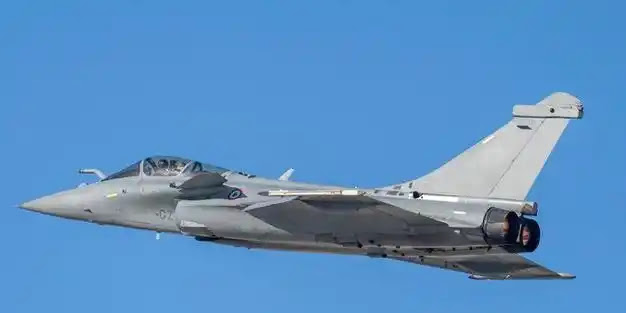Translate
2025年5月23日 星期五
2025年5月22日 星期四
2025年5月21日 星期三
2025年5月20日 星期二
Rafale crashes, China snickers, Modi dances, Trump goes nuts!
India’s nationwide
celebration of a supposed victory over Pakistan’s terrorist forces has been
called into question. Reports suggest that up to six Indian fighter jets were
shot down, with one French-made Rafale and one Russian-made Su-30 confirmed by
media sources. This India-Pakistan air battle involved aviation technology from
China, India, Pakistan, France, Russia, and Israel, and it has been dubbed the
first large-scale beyond-visual-range (BVR) air combat in human history, with
120 fighter jets from both sides engaged for over an hour. The Indian and
Pakistani governments have responded differently: India vehemently denies the
losses, seemingly deceiving its domestic audience, while Pakistan is suspected
of exaggerating its achievements. However, India’s defeat in this air battle is
now largely confirmed.
Looking at the entire
conflict, it’s clear that Pakistan’s air force alone could not have achieved
such a victory, including downing the Rafale, touted as a 4.5-generation
fighter second only to the American F-35. The fingerprints of China are evident
in every aspect of the operation, from strategic and tactical planning to
weapon use and intelligence operations. Pakistan orchestrated the conflict by
leveraging regional terrorist groups to provoke an incident, anticipating
India’s retaliatory airstrikes. Pakistan then deployed early-warning aircraft
and fighter jets along India’s likely approach routes, fully prepared for
combat. When Indian jets entered the ambush zone, they were attacked from long
range. Despite India’s numerical and technological superiority, their aircraft
were locked on by Pakistani early-warning systems, leaving them defenseless
against BVR attacks.
This wasn’t the first
time terrorist activities in the Kashmir region sparked conflict. India had
previously conducted retaliatory airstrikes, during which Pakistan’s air
defense missiles failed to respond, allowing India’s surprise attacks to
succeed. Emboldened by past successes, India underestimated Pakistan this time,
assuming they could easily cross the border and strike. However, they found
Pakistan fully prepared and waiting. India was forced to abandon its
cross-border plans, resorting to launching cruise missiles from a distance to
hit ground targets. Shockingly, the Rafale jets weren’t even equipped with
Meteor missiles for medium-to-long-range combat. Pakistan, on the other hand,
was ready for air combat, with early-warning aircraft guiding fighter jets to
launch a salvo of medium-range air-to-air missiles, catching the Indian air
force off guard. Pakistan’s JH-17, J-10CE, and early-warning aircraft worked in
tandem, forming a cohesive system that outmaneuvered India’s uncoordinated
forces. Despite India’s numerical and performance advantages, they suffered a
crushing defeat. The French Rafale, considered the world’s best outside of
stealth capabilities, and the Su-30, renowned for its close-range dogfighting
prowess despite its poor performance in the Russia-Ukraine conflict, were shot
down without even sighting their opponents.
China likely
masterminded this India-Pakistan air battle, using it as a strategic move to
gain leverage in the U.S.-China trade war. Recently, J.D. Vance, accompanied by
his Indian-American family, visited India to express the U.S.’s stance on
aligning with India to counter China. Known for his brash style and provocative
rhetoric, Vance has consistently stirred controversy. His meeting with
Zelenskyy sparked arguments, his encounter with the Pope led to a mysterious
death, and his visit to Modi triggered this India-Pakistan air battle. Wherever
he goes, chaos seems to follow. China, seeking a breakthrough in the trade war
with the U.S., identified Pakistan as its most reliable ally to pressure India.
India has long been a key pillar of Trump’s Indo-Pacific strategy to counter
China, making it an ideal target to disrupt Trump’s trade war tactics.
Moreover, with the Russia-Ukraine war at a stalemate, China prefers Russia to
remain in a state of neither winning nor losing decisively, diverting Western
attention from China. In the Middle East, Israel has largely subdued Hamas,
Iran is negotiating nuclear deals with the U.S., North Korea is bypassing China
in its military cooperation with Russia, and ASEAN countries in the South China
Sea need to be courted to counter the U.S. The Taiwan Strait involves U.S. and
Japanese intervention, leaving Pakistan as China’s most controllable ally to
act.
China not only
orchestrated this air battle but likely had military personnel directly
involved, choosing to fight within Pakistani territory to avoid escalation.
From fighter jets to early-warning aircraft, from operational planning to
execution, the battle reflected Chinese military philosophy: “Strike
unexpectedly, attack the unprepared,” “Never fight an uncertain battle,” “Never
fight an unprepared battle,” and “Lure the enemy deep and strike their
reinforcements.” The likelihood of this air battle escalating into full-scale
war between India and Pakistan is low, but limited military conflict is
inevitable given the threat to India. This conflict will not be resolved
through Trump’s mediation—he lacks the capability. Instead, China will likely
pull back once its objectives are met. By keeping India pinned down, China
ensures that if the conflict worsens, the U.S. cannot afford to ignore it, as
it would destabilize the Indo-Pacific strategy. Yet Trump, known for
prioritizing profit over war, will face pressure. If the U.S. doesn’t yield in
the trade war, China will continue using Pakistan to exert military pressure on
India. Trump, who has failed to mediate the Russia-Ukraine conflict, cannot
afford to ignore India either. If India and Pakistan escalate to full-scale war
alongside the Russia-Ukraine conflict, the U.S. will be stretched thin and
forced to negotiate with China, as everyone knows who Pakistan’s true backer
is.
As a result, Trump has
made a 180-degree turn, conceding on tariffs with China. The air battle has
also sparked interest among developing nations in Chinese aviation weapons.
Affordable and effective, these weapons proved capable of downing French and Russian
jets, an enticing prospect for cash-strapped countries with limited options.
Trump’s aggressive return to power, with bold claims of suppressing China, has
been met with China’s preparedness. Countless scholars, experts, think tanks,
and AI systems have studied Trump thoroughly, anticipating and countering his
moves before they even materialize. His strategies have largely failed, leaving
him to resort to simplistic rhetoric to deceive his domestic “redneck” base.
印巴空戰:陣風墜落,中國偷笑,莫迪狂舞,川普抓狂!
印度全國慶祝十天慶祝勝利打擊巴基斯坦恐怖勢力,但實情是據説最多有6架印度戰鬥機被擊落,其中法國陣風和俄羅斯Su-30各一架已被媒體證實,本次印巴空戰牽涉到中囯,印度,巴基斯坦,法國,俄羅斯和以色列的航空技術裝備,而且被定義爲人類歷史上第一次,大規模中遠距離視距外空戰,印巴空軍120架戰鬥機空戰1個小時之久。目前印巴政府反應不一,印度全面否認欺騙篇國內群衆,巴基斯坦也有誇大戰果之嫌,但印度空戰戰敗已基本確定了。
縱觀整個空戰僅憑藉巴基斯坦空軍根本不可能取得如此勝利,擊落號稱4代半僅次於美國F-35的最先進陣風戰鬥機,從整個作戰部署看無處不體現出中國的影子,無論從戰略戰術,武器使用和情報輿論等方面,本次巴基斯坦都是占據全面優勢。巴基斯坦通過控制地區的恐怖組織挑起事端,然後預判印度空軍必定報復,整裝待發在必經之路預先部署預警機和戰鬥機,並且做好一切戰鬥準備,待印度戰機進入伏擊圈後遠距離攻擊,印軍雖有數量優勢,而且戰鬥機性能遠超對手,但無奈早就被巴方預警機鎖定,最後被視距外擊落毫無還手之力。
印巴克什米爾地區的恐怖活動不止發生過一次,之前印度已經派空軍進行過報復,當時巴基斯坦防空導彈完全沒有反應,印度的突襲成功也造成了本次準備不足,自以爲按照以往經驗可以順利過境襲擊。但突然發現對方早有準備列陣以待,只能臨時取消入境作戰改爲遠距離發射巡航導彈襲擊地面目標,甚至陣風戰鬥機連中遠距離作戰的流星飛彈都沒帶,而巴方早就做好了空戰準備,不等印軍反應預警機引導戰鬥機,中距離空空導彈齊射印軍被打了個措手不及。巴基斯坦JH-17,殲-10CE和預警機互相配合形成體系,對抗印度戰機無導引下作戰,雖有數量和性能優勢但最後失敗收場。法國陣風除隱形性能外其餘世界第一,Su-30雖然在俄烏戰爭中表現不佳,但近距離空戰的纏鬥能力也是世界一流,結果還是被擊落甚至連對手飛機也沒看到。
中方主導了此次印巴空戰,目的是爲中美貿易戰找突破口,萬斯最近攜帶印度籍家眷訪問印度,代表美國表達聯印抗中的立場,以他一貫的張揚作風和激烈言辭,一直以來就引起各方的極度反感。與澤連斯基會面引發爭吵,與教宗會面導致突然死亡,與莫迪會面引發印巴空戰,所到之處事端不斷意外叢生。中國需要尋找對抗美國貿易戰討價還價的突破口,但環顧周邊也就是巴基斯坦針對印度最有威脅,印度一直以來都作爲特朗普印太戰略區針對中國的重要突破口,所以打擊印度不失爲平衡特朗普貿易戰的制衡點。況且俄烏戰爭陷入僵局,中方本就希望俄羅斯處於目前這種打不贏也不會輕易輸的局面,使得西方轉移打擊中國的視綫,中東地區以色列已將哈馬斯收拾得產不多了,伊朗正在與美國進行核武談判,朝鮮與俄羅斯軍事合作跳開中國,南海牽涉的東盟國家需要被拉攏對抗美國,臺海有美日介入,現在也只有完全控制的巴基斯坦可以出手。
中國不但主導了本次印巴空戰,而且極有可能直接派出軍事人員參戰,所以選擇巴方境內作戰不越境,況且從戰鬥機到預警機,從整個作戰預案到具體實施,“出其不意,攻其不備”,“不打無把握之仗”,“不打無準備之仗”,“誘敵深入,圍點打援”等,無處不體現中國軍事哲學傳統的特點。所謂空戰引發全面印巴戰爭可能性不大,印度受威脅下導致兩國有限軍事衝突是一定的,而且本次也絕非特朗普調停下停戰,他也沒有這個能力,而是中方見好就收。如此印度就被牽制住,如果衝突惡化美國不會置之不理,否則印太戰略區將被打破。但特朗普又是以賺錢爲主絕不打仗原則著稱的,只要美國在貿易戰上不讓步,中方就會利用巴基斯坦對印度施加軍事壓力,特朗普連調停俄烏戰爭都毫無作爲但又不能不管印度。如果印巴發動全面軍事衝突響應俄烏戰爭,美國必然無暇兼顧也不得不有求於中國,誰都知道巴方背後的大金主是誰。
因此特朗普也只好現在180度大轉彎在關稅上對中國讓步了,印巴空戰引起發展中國家對中國航空武器的濃厚興趣也是必然的,戰鬥機價廉物美擊落法俄戰機畢竟是個不小的誘惑,況且本來就資金不足選擇有限。特朗普再次上臺氣勢洶洶,打壓中方言之鑿鑿行動迅速有力,但中方早就對此有所準備,不知道有多少個國際問題學者,學者專家,智囊智庫,研究機構和AI,早就把特朗普研究透了,他上臺後的所謂招數沒有打出來就被破解,幾乎是全部失敗收場,最後也只能用小學生的英語,去欺騙美國國內的紅脖子了。






































.webp)

















